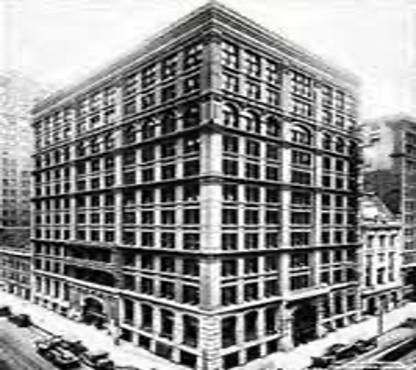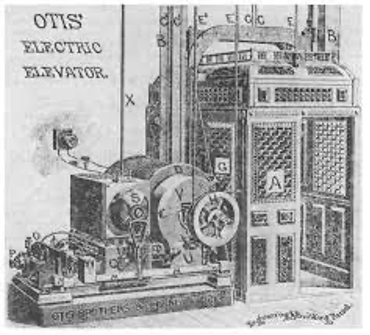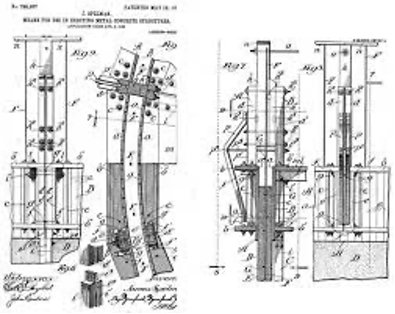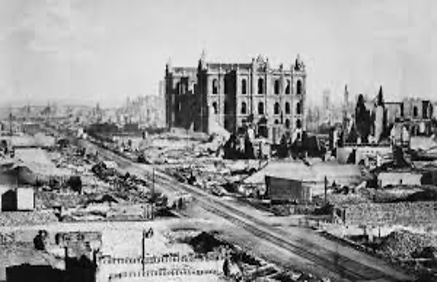In the late 19th and early 20th centuries, between 1880 and 1910, the Chicago School of Architecture developed as a notable architectural movement that created the modern skyscraper (Wright). It responded to the city’s rapid growth and the need for innovative designs to accommodate the burgeoning population (Wright). Several factors influenced this movement, including advances in fireproof building materials, the advent of hydraulic elevators, and the development of the Chicago Window style. This essay discusses the emergence of the Chicago school of architecture as facilitated by several factors, including fireproof materials, the advent of hydraulic elevators, and the development of the Chicago Window style.
One of the major factors that contributed to the Chicago School of Architecture was the availability of fireproof building materials. A string of devastating fires swept through the city, destroying much of the wooden infrastructure and resulting in the loss of many lives (Leslie). Architects recognized the need for new, more resilient building materials and turned to iron and steel as alternatives (Leslie). Using these materials led to the development of the skeleton frame construction method, which allowed buildings to be constructed without load-bearing walls (Leslie). Instead, the structure was supported by a steel or iron framework, which was much more fire-resistant than traditional wooden buildings. This innovation allowed architects to design taller and more open buildings than ever before, eventually leading to the modern skyscraper’s creation.
The two images below illustrate the great Chicago fire of 1871, retrieved from https://www.history.com/topics/19th-century/great-chicago-fire.
The first Chicago skyscraper, the Home Insurance Building, was constructed in 1885 and was an architectural breakthrough (Leslie). The building was 10 stories tall and was supported by a steel frame, making it the first building in the world to use this construction method. It allowed for the creation of large, open interior spaces and paved the way for the development of modern office buildings. The Chicago School of Architecture became known for its innovative designs and use of new materials and construction methods (Leslie). Architects like Louis Sullivan and Frank Lloyd Wright were at the forefront of this movement, creating buildings that were functional and beautiful. Several of the oldest famous structures in the world, including the Empire State Buildings and the Chrysler Buildings in New York City, bear the impact of the Chicago School.
Chicago School of Architecture: Skyscraper Design

Another key factor in developing the Chicago School of Architecture was the advent of hydraulic elevators. Hydraulic elevators were an important innovation that facilitated the development of skyscrapers (Vogel and Gray). Before their invention, buildings were limited in height because occupants had to climb multiple flights of stairs. The introduction of hydraulic elevators in the late 19th century revolutionized the design of buildings by making it possible to transport people and materials vertically (Vogel and Gray). Elisha Otis invented the first successful hydraulic elevator in 1852, but it was in the 1870s that it became widely adopted by architects and builders (Korom). The hydraulic elevator allowed architects to design taller buildings with more floors, which increased their capacity and efficiency. This innovation was critical to the development of the Chicago School and paved the way for the construction of skyscrapers worldwide (Korom).
https://www.jstor.org/stable/41613651

Chicago’s Other Skyscrapers: Grain Elevators and the City, 1838-1957

Finally, the Chicago School of Architecture was characterized by the development of the Chicago Window style. This style was characterized by large windows that extended from floor to ceiling, allowing natural light to flood into interior spaces (Miller). The Chicago Window Style was a response to the need for efficient lighting in tall buildings, which was necessary because electrical lighting was not yet widely available (Miller). The style also reflected the Chicago School’s commitment to functionalism, which emphasized the importance of buildings designed for their intended use rather than for aesthetic purposes alone (Miller). The use of large windows not only provide natural light but also offered a sense of openness and transparency that was a departure from the solid masonry walls of earlier buildings.
The Chicago Window

In conclusion, the Chicago School of Architecture was a significant movement in American architecture that emerged between 1880 and 1910. Its impact on the development of the modern skyscraper cannot be overstated, as several factors, including advances in fireproof building materials, the advent of hydraulic elevators, and the development of the Chicago Window style, influenced the movement. Using steel and iron frameworks, hydraulic elevators, and large windows transformed the design of buildings, enabling architects to create taller and more efficient structures. Today, the Chicago School of Architecture remains an important part of American architectural history and a testament to the ingenuity of architects and builders in response to the challenges of rapid urbanization and technological progress.
Works Cited
Korom, Joseph J. “The American Skyscraper, 1850-1940: A Celebration of Height.” Google Books, Branden Books, 2008, books.google.co.ke/books?hl=en&lr=&id=JVzYO1TyZ6AC&oi=fnd&pg=PA4&dq=The+first+successful+hydraulic+elevator+was+invented+by+Elisha+Otis+in+1852. Accessed 22 Mar. 2023.
Leslie, Thomas. “Chicago Skyscrapers, 1871-1934.” Google Books, University of Illinois Press, 2013, books.google.co.ke/books?hl=en&lr=&id=CKAPMsks08AC&oi=fnd&pg=PP2&dq=One+of+the+major+factors+that+contributed+to+the+Chicago+School+of+Architecture+was+the+availability+of+fireproof+building+materials. Accessed 22 Mar. 2023.
Miller, Hugh C. “The Chicago School of Architecture: A Plan for Preserving a Significant Remnant of America’s Architectural Heritage.” Google Books, U.S. National Park Service, 1972, books.google.co.ke/books?hl=en&lr=&id=Y2YLKwk_4l4C&oi=fnd&pg=PP10&dq=Finally. Accessed 22 Mar. 2023.
Vogel, Robert, and Lee E. Gray. “Review of from Ascending Rooms to Express Elevators: A History of the Passenger Elevator in the Nineteenth Century.” I.A. The Journal of the Society for Industrial Archeology, vol. 31, no. 1, 2005, pp. 55–57, www.jstor.org/stable/40968689. Accessed 22 Mar. 2023.
Wright, Gwendolyn. “USA: Modern Architectures in History.” Google Books, Reaktion Books, 2008, books.google.co.ke/books?hl=en&lr=&id=RMuO2VsR2q8C&oi=fnd&pg=PA7&dq=The+Chicago+School+of+Architecture+emerged+as+a+significant+movement+in+American+architecture+between+1880+and+1910+that+is+in+the+late+19th+and+early+20th+centuries. Accessed 22 Mar. 2023.

 write
write